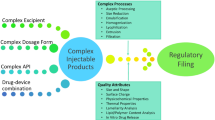Abstract
The major aims of the present study were (1) to select a multiple-unit formulation that matched the in vitro dissolution profile of single-unit sustained-release commercial capsules, (2) to compare the sustaining/controlling efficacy of the selected multiple-unit formulation with that of the single-unit commercial conventional tablet and sustained-release capsules, and (3) to determine whether an in vitro-in vivo correlation exists for single- and multiple-unit formulations. Ibuprofen (20%–60% wt/wt)-loaded multiple-unit polystyrene microparticles were prepared by an emulsion-solvent evaporation method from an aqueous system. The in vitro release profiles obtained in phosphate buffer of pH 6.8 for drug-loaded polystyrene microparticles and for commercial sustained-release capsules (Fenlong-SR, 400 mg) were compared. Since the microparticles with 30% ibuprofen load showed a release profile comparable to that of the Fenlong-SR release profile, the microparticles with this drug load were considered to be the optimized/selected formulation and, therefore, were subjected to stability study and in vivo study in human volunteers. A single-dose oral bioavailability study revealed significant differences in Cmax, Tmax, t1/2a, t1/2e, Ka, Ke, and AUC between the conventional tablet and optimized or Fenlong-SR capsule dosage forms. However, all the parameters, with the exception of Ka along with relative bioavailability (F) and retard quotient (RΔ), obtained from the optimized ibuprofenloaded microparticles were lower than that obtained from the commercial Fenlong-SR formulation. Furthermore, linear relationship obtained between the percentages dissolved and absorbed suggests a means to predict in vivo absorption by measuring in vitro dissolution.
Similar content being viewed by others
References
Bechgaard H, Nielsen GH. Controlled-release multiple-units and single-unit doses. A literature review.Drug Dev Ind Pharm. 1978; 4:53–67.
Beckett AH. Altermative routes of drug administration and new drug delivery systems. In: Breimer DD, ed.Towards Better Safety of Drugs and Pharmaceutical Products. New York, NY: Elsevier/North-Holland Biomedical Press; 1980:247–263.
Davis SS, Hardy JG, Taylor MJ, Whalley DR, Wilson CG. A comparative study of the gastrointestinal transit of a pellet and tablet formulation.Int J Pharm. 1984;21:167–177.
Gennaro AR, Chase GD, Der Marderosian A, eds.Remington’s Pharmaceutical Sciences, 18th ed. Easton, PA: Mack Publishing Company; 1990.
Rossi S.Australian Medicines Handbook 2004. Adelaide, Australia: Australian Medicines Handbook; 2004.
Tamilvanan S, Sa B. Effect of production variables on the physical characteristics of ibuprofen-loaded opolystyrene microparticles.J Microencapsul. 1999;16:411–418.
United States Pharmacopoeia XXII. Rockville, MD: US Pharmacopoeial Convention Inc; 1990.
British Pharmaceutical Codex. London, UK: Pharmaceutical Press; 1976.
Higuchi T. Mechanism of sustained-action medication: theoretical analysis of rate of release of solid drugs dispersed in solid matrices.J Pharm Sci. 1963;52:1145–1149.
Bamba M, Puisieux F, Marty JP, Carstensen JT. Release mechanisms in gelforming sustained release preparations.Int J Pharm. 1979;2: 307–315.
Hixson AW, Crowell JH. Dependence of reaction velocity upon surface and agitation, I: theoretical considerations.Ind Eng Chem. 1931;23:923–931.
Shah MV, De Gennaro MD, Suryakasuma H. An evaluation of albumin microcapsules prepared using a multiple emulsion technique.J Microencapsul. 1987;4:223–238.
Lund W.The Pharmaceutical Codex. London, UK: Pharmaceutical Press; 1994.
Adeyeye CM, Price JC. Chemical, dissolution stability and microscopic evaluation of suspensions of ibuprofen and sustained release ibuprofen-wax microspheres.J Microencapsul. 1997;14: 357–377.
Lamprecht A, Saumet JL, Roux J, Benoit JP. Lipid nanocarriers as drug delivery system for ibuprofen in pain treatment.Int J Pharm. 2004;278:407–414.
Rowland M, Tozer TN.Clinical Pharmacokinetics: Concepts and Applications. New Delhi, India: BI Waverly Pvt Ltd; 1996:478–480.
Rowland M, Tozer TN.Clinical Pharmacokinetics: Concepts and Applications New Delhi, India: BI Waverly Pvt Ltd; 1996:469–472.
Silber M, Bialer M, Yacobi A. Pharmacokinetic and pharmacodynamic basis of controlled drug delivery. In: Robinson JR, Lee VHL, eds.Controlled Drug Delivery, Fundamentals and Application. New York, NY: Marcel Dekker; 1987:225–230.
Maturu PK, Prasad VK, Worsley WN, Shiu GK, Skelly JP. Influence of a high fat breakfast on the bioavailability of theophylline controlled-release formulations: an in vivo observation.J Pharm Sci. 1986;75:1205–1206.
Tamilvanan S, Biswanath SA. Effect of drug-load on the internal structure of ibuprofen-loaded polystyrene microparticles.Acta Pol Pharm. 1999;56:221–226.
Block LH, Banakar UV. Further considerations in correlating in vitro-in vivo data employing mean time concept based on statistical moments.Drug Dev Ind Pharm. 1988;14:2143–2150.
Benet LZ. Design and optimization of dosage regimens: pharmacokinetic data. In: Hardman JG, Limbird LE, Molinoff PB, Ruddon RW, Goodman AG, eds.Goodman & Gilman’s The Pharmacological Basis of Therapeutics. 9th ed. New York, NY: McGraw-Hill; 1996:1702–1792.
Riegelman S, Collier P. The application of statistical moment theory to the evaluation of in vivo dissolution time and absorption time.J Pharmacokinet Biopharm. 1980;8:509–534.
Shargel L, Yu ABC.Applied Biopharmaceutics and Pharmacokinetics. New York, NY: Prentice-Hall International Inc; 1993:505.
Meier J, Nuesch E, Schmidt R. Pharmacokinetic criteria for the evaluation of retard formulations.Eur J Clin Pharmacol. 1974;7:429–432.
Borin MT, Khare S, Beihn RM, Jay M. The effect of food on gastrointestinal (GI) transit of sustained-release ibuprofen tablets as evaluated by gamma scintigraphy.Pharm Res. 1990;7:304–307.
Wilson WI, Peng Y, Augsburger LL. Comparison of statistical analysis and Bayesian networks in the evaluation of dissolution performance of BCS Class II model drugs.J Pharm Sci. 2005;94: 2764–2776.
Kottke MK, Rhodes CT. Limitations of presently available in vitro release data for the prediction of in vivo performance.Drug Dev Ind Pharm. 1991;17:1157–1176.
Reynolds JEF.Martindale, The Extra Pharmacopoeia. London, UK: Royal Pharmaceutical Society; 1996:50.
FDA Guidance for Industry on Extended Release Oral Dosage Forms.Development, Evaluation and Application of In Vitro/In Vivo Correlations. Rockville, MD: FDA, Center for Drug Evaluation and Research; 1997.
Ishii K, Saitou Y, Yamada R, Itai S, Nemoto M. Novel approach for determination of correlation between in vivo and in vitro dissolution using the optimization technique.Chem Pharm Bull (Tokyo). 1996; 44:1550–1555.
Lin SY, Yang JC. Moment analysis for the evaluation of in vitro drug release and in vivo bioavailability of theophylline microcapsules.Drug Dev Ind Pharm. 1998;14:805–817.
Liu FY, Sambol NC, Giannini RP, Liu CY. In vitro-in vivo relationship of oral extended-release dosage forms.Pharm Res. 1996;13:1501–1506.
Author information
Authors and Affiliations
Corresponding author
Additional information
Published: September 1, 2006
Rights and permissions
About this article
Cite this article
Tamilvanan, S., Sa, B. In vitro and in vivo evaluation of single-unit commercial conventional tablet and sustained-release capsules compared with multiple-unit polystyrene microparticle dosage forms of ibuprofen. AAPS PharmSciTech 7, 72 (2006). https://doi.org/10.1208/pt070372
Received:
Accepted:
Published:
DOI: https://doi.org/10.1208/pt070372




